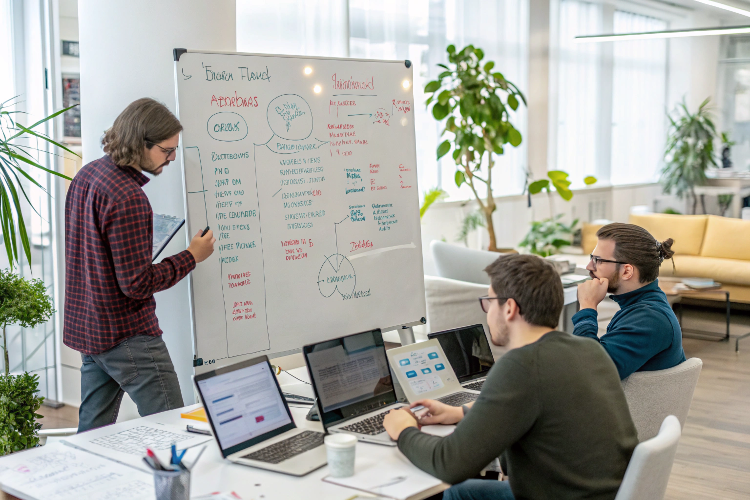Blog
How to Choose the Right Tech Stack for Your Web Project
Web Development & Design ▪ 2025-03-07

In today’s digital era, choosing the right tech stack for your web development project is crucial to its success. A well-chosen tech stack ensures scalability, maintainability, performance, and security. Whether you’re building a startup website, an e-commerce platform, or a complex web application, selecting the appropriate technologies can make or break your project. In this comprehensive guide, we will explore how to choose the right tech stack for your web project, considering key factors such as business goals, budget, development speed, and future scalability.
What Is a Tech Stack?
A tech stack is a combination of programming languages, frameworks, libraries, and tools used to develop a software application. It typically consists of two main components:
-
Frontend (Client-side): The part of the application users interact with directly (e.g., HTML, CSS, JavaScript frameworks like React, Vue.js, or Angular).
-
Backend (Server-side): The logic and database management that power the application (e.g., Node.js, Django, Ruby on Rails, Laravel).
-
Database: Where all the application data is stored (e.g., MySQL, PostgreSQL, MongoDB, Firebase).
-
DevOps & Hosting: Tools for deployment, server management, and automation (e.g., AWS, Azure, Docker, Kubernetes).
Factors to Consider When Choosing a Tech Stack
1. Project Requirements and Goals
Before selecting a tech stack, clearly define your project’s scope, objectives, and expected outcomes. Consider:
-
Is your project a simple website, an e-commerce platform, or a large-scale enterprise application?
-
Will your application require real-time functionality (e.g., live chat, stock market updates)?
-
What are your security and compliance needs?
2. Development Speed & Time to Market
If you need to launch your product quickly, opt for technologies that offer rapid development capabilities. Frameworks like Ruby on Rails, Django, and Laravel provide pre-built functionalities that speed up development.
3. Scalability
Your tech stack should be able to handle growth. Consider:
-
Horizontal scaling: Adding more servers to handle increased traffic.
-
Vertical scaling: Enhancing server capabilities to support high loads.
-
Cloud-based solutions like AWS, Google Cloud, and Azure for better scalability.
4. Budget Considerations
Your budget impacts the tech stack selection. Some key financial aspects to consider:
-
Open-source vs. proprietary software (Open-source solutions like React, Vue.js, and Django are cost-effective).
-
Infrastructure costs (Cloud vs. on-premise solutions).
-
Developer salaries (Some technologies have higher demand, leading to higher costs).
5. Technology Popularity and Community Support
Choosing a widely adopted technology ensures longevity and a robust developer community for troubleshooting. Technologies like JavaScript, Python, Node.js, and React have extensive communities.
6. Security
Cybersecurity is a top priority in web development. Your stack should have strong security features to prevent vulnerabilities. Frameworks like Django and Spring Boot come with built-in security mechanisms.
Popular Tech Stacks for Web Development
1. MERN Stack (MongoDB, Express.js, React, Node.js)
-
Best for full-stack JavaScript applications.
-
Ideal for dynamic web apps and single-page applications (SPAs).
-
Large community support and flexibility.
2. MEAN Stack (MongoDB, Express.js, Angular, Node.js)
-
Similar to MERN but uses Angular for front-end development.
-
Good for enterprise-grade applications.
3. LAMP Stack (Linux, Apache, MySQL, PHP)
-
Traditional stack used for CMS platforms like WordPress, Joomla, and Drupal.
-
Highly stable and secure.
4. Django + PostgreSQL
-
Python-based stack ideal for data-driven applications.
-
Great for scalability and security.
5. Ruby on Rails + PostgreSQL
-
Rapid development framework for startups and MVPs.
-
Offers conventions that speed up development.
Making the Final Decision
Step 1: Define Your Business Objectives
-
Are you building a prototype, an MVP, or a fully functional product?
-
What are the long-term goals?
Step 2: Evaluate Your Team’s Expertise
-
Do you have experienced developers for the chosen stack?
-
Will you need to hire new developers?
Step 3: Consider Performance & Scalability Needs
-
Will your application handle thousands or millions of users?
-
Do you need real-time data processing?
Step 4: Review Security & Maintenance Requirements
-
How often will your application need updates and patches?
-
Do you need built-in security features?

